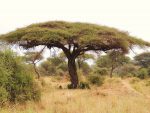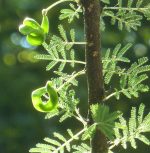 Also known as umbrella thorn and Israeli babool, this mediium to large tree is native to arid and semi-arid regions of Africa but grows also in the Middle East including Isrealwhere it grows in deserts, woodlands, and shrublands. It is a member of the legume family, Fabaceae, that also includes beans, lupines, and black locust. The umbrella shaped trees may have multiple trunks and grow 13-49′ tall but may be a shrub less than 3′ under very arid condition. The stems bear two types of thorns, one long, straight, and white, the other small, hooked and brownish. The bipinnate leaves are up to 1″ long and have 4-10 pinnae, each with about 15 pairs of tiny leaflets. The sweet scented, creamy white flowers have extruded stamens and are carried in condensed, head-like spikes from late spring to early summer. The flowers give way to a flat, coiled, spring-like pod containing flat dark brown seeds. The wood of twisted acacia is a good as timber and the pods and leaves are as fodder for grazing desert animals. Plants are tolerant of drought, salinity, high temperatures, alkalinity, and wind and fix nitrogen in the soil so are valuable in reclaiming land in difficult sites. The genus name, Acacia, is from the Greek word akis, meaning a point or a barb and refers to the thorns. The genus name, Vachell, honors George Harvey Vachell (1789-1839) chaplain to the British East India Company in Macoa, plant collector in China. The specific epithet, raddiana, honors Giusepe Raddi (1770-1829), Italian botanist who studied the Egyptian hieroglyphs under the direction of Champollion. The specific epithet, tortilis, is the Latin word meaning twisted and refers to the shape of the p0ds.
Also known as umbrella thorn and Israeli babool, this mediium to large tree is native to arid and semi-arid regions of Africa but grows also in the Middle East including Isrealwhere it grows in deserts, woodlands, and shrublands. It is a member of the legume family, Fabaceae, that also includes beans, lupines, and black locust. The umbrella shaped trees may have multiple trunks and grow 13-49′ tall but may be a shrub less than 3′ under very arid condition. The stems bear two types of thorns, one long, straight, and white, the other small, hooked and brownish. The bipinnate leaves are up to 1″ long and have 4-10 pinnae, each with about 15 pairs of tiny leaflets. The sweet scented, creamy white flowers have extruded stamens and are carried in condensed, head-like spikes from late spring to early summer. The flowers give way to a flat, coiled, spring-like pod containing flat dark brown seeds. The wood of twisted acacia is a good as timber and the pods and leaves are as fodder for grazing desert animals. Plants are tolerant of drought, salinity, high temperatures, alkalinity, and wind and fix nitrogen in the soil so are valuable in reclaiming land in difficult sites. The genus name, Acacia, is from the Greek word akis, meaning a point or a barb and refers to the thorns. The genus name, Vachell, honors George Harvey Vachell (1789-1839) chaplain to the British East India Company in Macoa, plant collector in China. The specific epithet, raddiana, honors Giusepe Raddi (1770-1829), Italian botanist who studied the Egyptian hieroglyphs under the direction of Champollion. The specific epithet, tortilis, is the Latin word meaning twisted and refers to the shape of the p0ds.
 Type: Evergreen tree
Type: Evergreen tree
Outstanding Feature: Wood
Form: Umbrella unless in extreme conditions
Growth Rate: Slow
Bloom: Small creamy white flowers in condensed head-like spikes in late spring to early summer
Size: 13-49′
Light: Full sun
Soil: Average to lean, dry to medium moist, well-drained; tolerant of many soil types
Hardiness: Zones 10-12
Care: Low maintenance
Pests and Diseases:Bruchid beetle,mimosoid blights, caterpillar, termites, and grazing mammals
Propagation: Seed with concentrated suphuric acid treatment for 30minutes; germination slow
Photo Credits: Wikipedia, Wikipedia